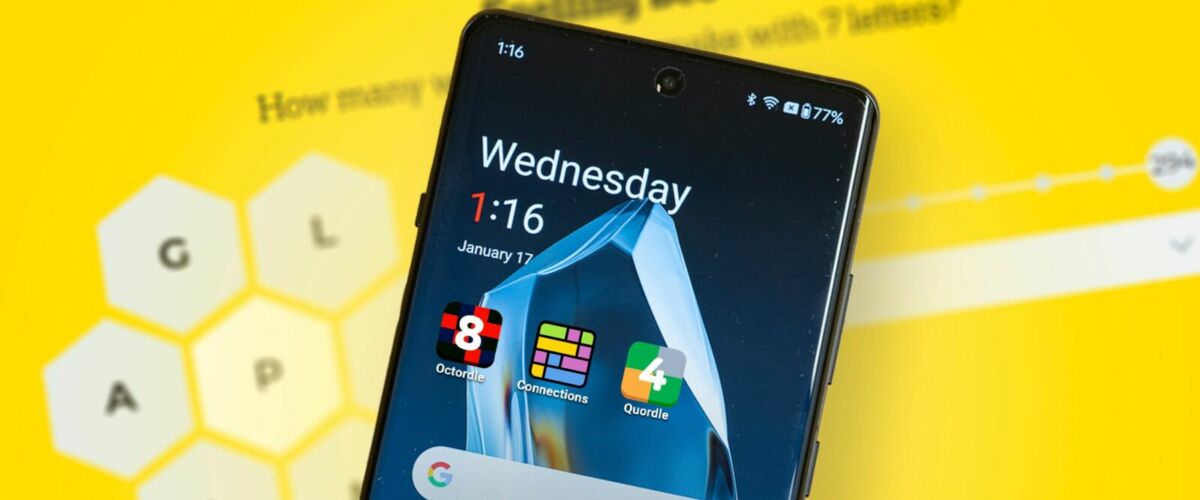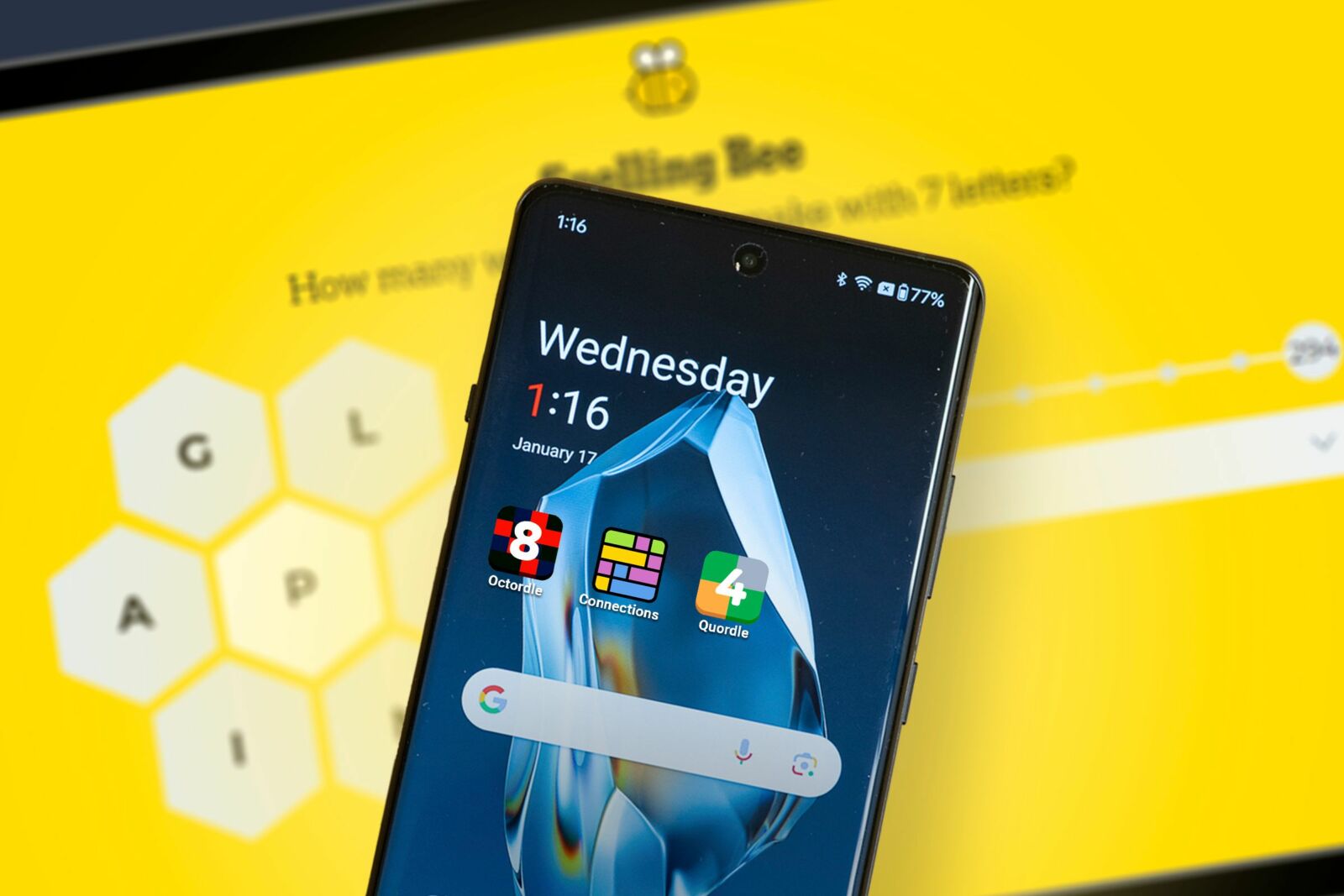7 Word Games I Play After I Complete Wordle
Finished today’s Wordle? Try these other fun word games!
Quick Links
- Quordle
- Octordle
- WeWordle
- Puzzly Words
- Full Rainbow
- The NYT Spelling Bee
- The NYT Connections
While studies suggest that word games don’t actually do anything to train your brain, I sometimes feel unfulfilled by Wordle alone. As a result, I find myself going through a daily mega word game hour. If you enjoy Wordle, there are plenty of other games that scratch a similar itch—here are some of my favorites.
1. Quordle
Provided by Merriam-Webster, Quordle challenges you to solve four Wordle-type puzzles in one go. You get nine attempts to crack all four words, compared to the six attempts you’re given in Wordle to guess one word. I always start with the same words as on Wordle—”pious,” “rated,” and (if needed) “lynch”—as I’ve covered all the vowels and many of the commonly-used letters in the first two goes.
Once you’ve completed today’s Quordle, you’ll see the star at the top turn yellow, giving you access to the weekly Quordle. This is much more difficult, as it tends to involve obscure words with some of those letters you usually leave to the end.
Finally, if you tap the blue bar along the top of your screen, you’ll see the sequential version of the game. For this, you have to crack each word one at a time, only moving onto the next once you’ve done the previous. You get ten goes for this version, recognition that it’s possibly trickier again than the regular Quordle game.
2. Octordle
Now that you’ve warmed up, it’s time to ramp it up to the next level: I give you Octordle. As the name suggests, this game, brought to you by Britannica, requires you to work out eight words at a time. For this game, you get 13 attempts, a nod towards its further difficulty. When you first play this game, you might find that it’s frustrating not being able to see all eight grids at the same time. However, you do get used to scrolling up and down, and the numbers along the top of the keyboard turn green when you’ve cracked each word, making it easier to track your progress.
Again, starting with “pious,” “rated,” and “lynch” usually gives me the foundations to complete this game with a couple of goes to spare, though you should definitely be prepared for one or two words you’ve never heard of before!
Moving across the horizontal menu along the top, you’ll see the sequence and rescue versions of Octordle. As with Quordle, the sequence format requires you to solve one word at a time in order but gives you a generous 15 attempts to do so. I often find this easier than the standard Octordle game.
Rescue is much harder. You can forget about your usual starting words, as you’re given four ready-made starting rows (usually poor choices for starting words!), and you have to guess all eight words within the final nine remaining attempts. This means you can only add one strategic word or make one mistake, and you’re at the game’s mercy. The best strategy here is to take your time! You’ll often find that many strings of letters could solve your words, so really thinking about the combinations across all eight words is key.
3. WeWordle
If you fancy taking someone on at Wordle, you can play WeWordle. In this game, you take turns adding a word to the board, and you can also add a time limit to each go if you wish. Think carefully, though. You don’t want to reveal too much to your opponent, but you also want to give yourself a good chance of guessing the word on your next turn.
In the example above, my opponent started with “house,” I followed up with “ridge,” and in the sixth turn, I correctly went with “fibre.” You can play someone you know by sending a link, or simply tap “Random Opponent” to start a game straight away. Either way, the game randomly selects who goes first.
4. Puzzly Words
If you’re looking for a more intense game, then the Puzzly Words app (available on Android, iPhone, and iPad) is the one for you. Personally, I’m addicted to it! You have four one-minute rounds in which you must use as many letters as you can to create three words.
Sounds simple, right? But hold on. Look out for DW (double word) and TW (triple word) tags on some of the letters. This means that any words you create using these letters will double or triple the overall score for that word. What’s more, if you use letters with a DL (double letter) or TL (triple letter) tag with a double-word or triple-word letter, you’ll score even more.
Like in Scrabble, some letters are worth more points than others, so if you can combine the higher-scoring words with the doubles and triples, you’re in for an impressive score. Look out for useful letter combinations, such as -ing, -ed, -er, out-, and under-, and have some good vowel-heavy words up your sleeves, such as “liaise,” “aioli,” “cooee,” and “queue.”
Over time, you get free coins for playing, which you can use to add letters to the available group (useful if you’re struggling for words or want to distract your opponents). You can also use them to add more time or validate your words.
Try to use as many letters as you can and in the shortest time possible. If you’re tied with someone else at the end of the game, letters used and time taken will be used to decide who wins.
You can play this exciting game with your friends or with strangers.
5. Full Rainbow
British broadcaster and logophile Gyles Brandreth came up with this game. Full Rainbow is simple and quick, yet challenging and (sometimes) frustrating. As with Wordle, you get one of these a day.
You have up to three minutes to create a seven-letter word from the letters provided. Simply click and drag the letters down to the board at the bottom to make the word. If you’re stuck, you can get up to three hints by tapping the question mark in the top-right corner, but each hint will cost you 30 seconds.
Whether you’re awarded a full rainbow, rainbow, half rainbow, quarter rainbow, or rainboo depends on how long you take to complete the game, how many hints you take, and how many moves you make.
As with many word games, looking out for common letter patterns will help you along the way. The key is not to panic—you have 45 seconds to achieve the full rainbow.
6. The NYT Spelling Bee
Another popular but infuriating game, The NYT Spelling Bee, can really draw you in. You’re given six letters around a central letter to create high-scoring words.
The rules are simple—each word must be at least four letters in length and contain the central letter. You can’t use proper nouns, hyphenated words, or expletives. But you can use a letter more than once. The longer the word, the more you’ll score. And if you use all the letters in one go, you’ll get an extra seven points.
If you aren’t a subscriber, the game will end when you get a “solid” score. Otherwise, you have all day to find as many words as you can! The route to success in this game is to use the shuffle button at the bottom of the screen, as this will change the order of the outside letters, and you will spot new word patterns.
7. The NYT Connections
Those of you to the east of the Atlantic might have seen this game on the BBC TV program, Only Connect. Those who haven’t should definitely give The NYT Connections game a go. You have to find four groups of connections within the words presented to you.
You only have room for four errors, and once it’s game over, you’ll have to wait until tomorrow for the next game. But be careful! You might think that you have a group, but some words could potentially fit into two or more groups. There’s no time limit, so try to get the connections sorted in your head before you go ahead and submit them.
And there you have it! Seven word games with different levels of challenge to add to your daily brain workout.
“Tech Bargains Galore: Where Innovation Meets Affordability!”






